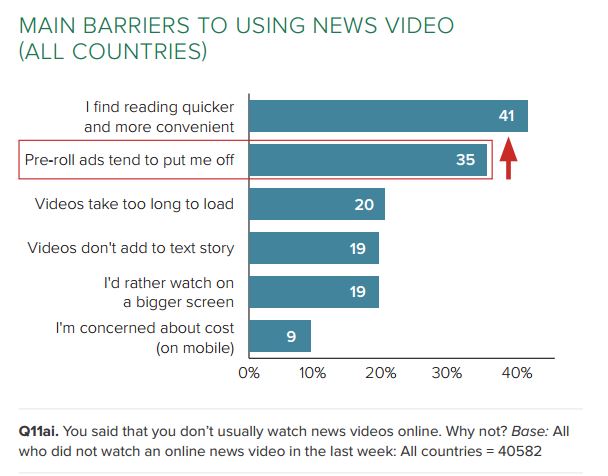Recently the Reuters Institute for the Study of Journalism published its annual Digital News Report, authored by Nic Newman.
If you’re interested in the media, and particularly journalism in the digital age, then it’s an essential read. The report, which is supported by groups such as Google and the BBC, surveys 50,000 people across 26 countries about their digital news habits.
The report is available to download, with lots of additional resources like data tables and chart packs for deep-diving into.
I’m going to concentrate on one area of the report: video.
If you’ve been paying attention to news sites, and indeed digital media in general, there has been a lot more video in recent years. Social media and news sites more often than not playing videos by default, and spending money to push the platform. Video, the belief is, will grab users’ attention and drive increased readership.
And for the most part, this seemed like a sensible move. More people were watching more video as both home broadband and mobile 4G coverage improved. But with regard to digital news, there’s been a bit of a speed-bump on the road.
“One surprise in this year’s data is that online news video appears to be growing more slowly than might be expected. Across all 26 countries only a quarter (24%) of respondents say they access online news video in a given week. This represents surprisingly weak growth given the explosive growth and prominence on the supply side.”
(Page 19)
The real reason for the growth in video, beyond the perceived demand from users, is the higher advertising yields that can be achieved from video. Those pre-roll adverts, whether skippable or not, are worth much more than other display inventory which has not been the saviour that news organisations or others had hoped it would be. Something to do with infinite inventory I suspect.
News providers were positively driven to increase their volumes of video to meet revenue targets.
“Across our entire sample, the vast majority (78%) say they only read news in text or occasionally watch news video that looks interesting. Just one in twenty (5%) say they mostly watch rather than read news online. “
(Page 20)
And the reasons for this relatively low growth are pretty obvious. This chart is from the report:
I think those reasons – the first four in particular – chime with me, with the fact that I can read text quicker than watch a video being the chief one.
Yet frustratingly, more news seems to be appearing in video-only form. I read much of my news via the feedreader Feedly, and most news site’s RSS feeds limit what Feedly can see. That’s fine – whether coming from a feedreader, or much more likely, social media, news providers want to ensure they have strong branding and potentially monetise me with advertising.
But when I click through to a site and see a story that is only, or mostly, video, then I simply close the tab and click away.
Video really needs to add something to what I can read for it to be of true value. I’m not saying I don’t like video news – I watch TV news bulletins on a daily basis – but in a digital world, video is much more an interruptor.
– If I’m on the train to work looking on my mobile, I may be listening to music. Video puts that on pause so I can hear the soundtrack. Newspapers never forced that on me. I can read text and listen to music simultaneously.
– If I’m at work, then I can quickly scan a story to see if it’s important. With video I have to fumble around for headphones, or risk interrupting colleagues.
And video takes time. From hitting the play button to getting to what I want to see is not usually the best experience. Frankly, there’s nothing worse than a news provider who has built their own video platform (or bought one), and you just know it’s not going to be as fast-starting as, say, YouTube. You’re going to see a swirly “loading” graphic before an advert loads painfully slowly. At the end of the advert, there’ll be another delay as the actual video loads. 30 seconds of that before a video that’s only 45 seconds long itself doesn’t seem like a fair transaction.
Fundamentally, humans can read in their heads faster than someone can read out loud. So all things being equal, I’ll choose the most the most efficient way to get to the story. For the most part, I want to read stories not watch videos. I can quickly gauge how interested I am in a story from the text. Video is a hit or miss affair.
It’s perfectly true that some may prefer video, so by all means offer both video and text. But consider even making the transcript of the video available. As a friend pointed out on a social media, that instantly makes the video more accessible, and increases the search engine optimisation of what you’re producing.
Video is actually much more expensive than text – or text illustrated by photos – yet everyone seems to want to do it.
My suggestion is that unless video is a primary output of your organisation, I would use it sparingly. Produce only videos that really add something to the story. There are various groups who are adding text to videos and making them viewable without sound. Fine as far as it goes, but they tend to be relatively simplistic. You can’t delve deeper into a story that way, yet if I’m spending 2-3 minutes with a story which is what a video is demanding of me, then I expect to come out with a much richer understanding of the issues than I went in with.
Video is not the be-all and end-all, and news providers would do well to remember that.

